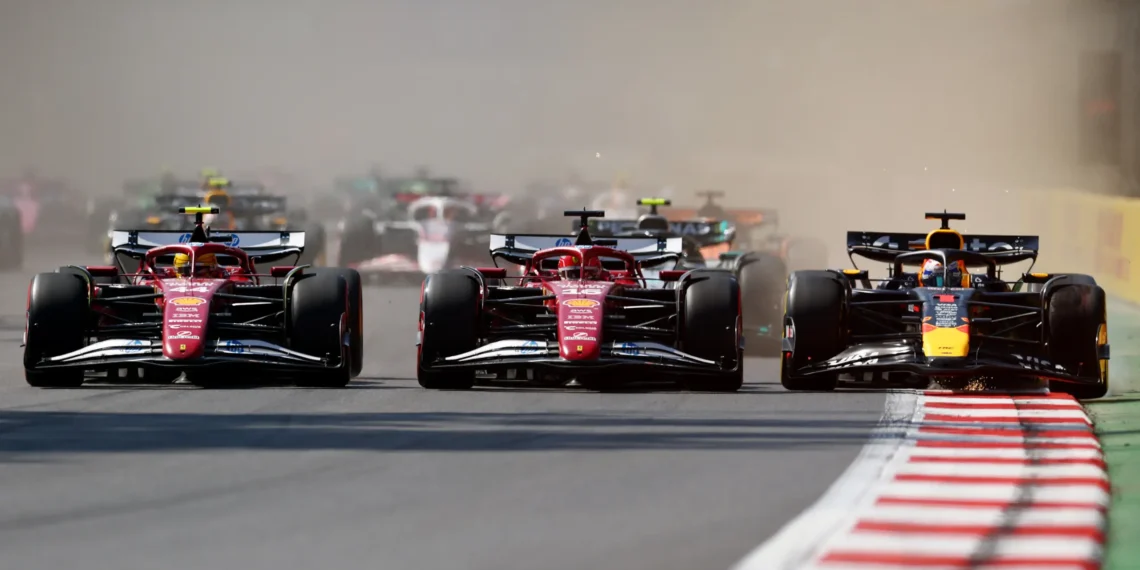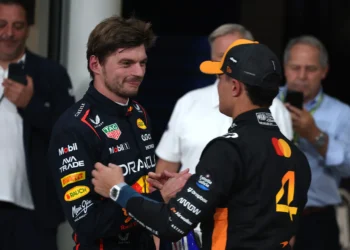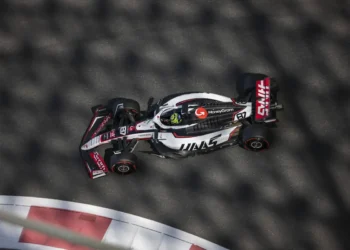Is Turn 1 at the Mexico GP a Recipe for Chaos?
The adrenaline-fueled world of Formula 1 just witnessed a shocking display of driving that has left fans and experts alike questioning: does the Mexico Grand Prix have a severe Turn 1 problem? Renowned driver George Russell didn’t mince words when he criticized his competitors, suggesting their driving standards were akin to “lawnmower-worthy.” Strong words, but are they justified?
The infamous Turn 1 at the Autodromo Hermanos Rodriguez became the epicenter of controversy once again during the recent race. Picture this: Lando Norris, Lewis Hamilton, Charles Leclerc, and Max Verstappen all entering the corner four-wide. It’s a scene that could only lead to chaos! Verstappen, battling for position, locked up on the dusty outside kerb, effectively slicing across the corner. Meanwhile, Hamilton appeared to grant Leclerc the requisite space but was left bewildered as the Monegasque cut across Turn 2, emerging in the lead and letting Norris through, all while gaining a crucial advantage over his teammate.
This track’s design clearly narrows in the Turn 1-2-3 section, making it a veritable bottleneck where four cars simply cannot coexist without consequences. Historically, the Mexico GP has seen its fair share of orderly race starts since its return to the Formula 1 calendar in 2015. However, the frequency of track cutting has raised significant concerns about the integrity of racing and the fairness of competition. When does a driver push the limits of racing versus when do they gain an unfair advantage?
Let’s rewind to 2016, when Hamilton himself locked up and veered off, mirroring Verstappen’s recent misstep. Nico Rosberg, also caught in the fray, cut the corner while being pushed wide and re-entered the race ahead of Verstappen, with no penalties from the stewards. The inconsistency raises eyebrows: if Hamilton was ahead going into the Turn 1 braking zone, did he have the right to the lead despite his blunder?
Fast forward to last year, when Carlos Sainz attempted to snatch the lead from Verstappen by taking the outside line. Despite being ahead at the apex, should he have yielded instead of cutting the corner? The dilemma is real, and it’s been a persistent theme in racing. Drivers often face the choice: slow down and risk losing their hard-fought positions or cut the corner and risk penalties.
In stark contrast to the present-day confusion, there have been instances where drivers have fiercely battled for their positions without resorting to corner-cutting. Take Sebastian Vettel in 2017, who, despite being pushed wide by Verstappen, managed to hold his ground and capitalize on the inside line into Turn 2. This is the kind of relentless racing spirit that should prevail, yet we saw Leclerc falter instead, failing to regroup and mount a challenge against Hamilton later in the race.
The question looms: how do we fix this persistent issue at Turn 1? The answer is anything but straightforward. Grass has proven ineffective in slowing down cars, while gravel could theoretically work but would lead to debris on the track, triggering virtual safety cars that skew race outcomes. What if a wall were introduced? That would certainly deter reckless driving, but at speeds reaching 370 km/h, such a solution would likely clash with FIA safety standards.
The only logical option left is a layout modification, yet why tamper with a section that has the potential for exhilarating racing—provided drivers adhere to the rules? Fernando Alonso, ever the strategist, hinted at the absurdity of the current situation, pointing out that if the stewards let Leclerc and Verstappen’s antics slide without penalties, then why shouldn’t he do the same next time around?
The governing body must make a decisive stand. Either penalize drivers who unlawfully push others off the track, or penalize those who cut corners—let’s make it black and white! Yes, there will always be unique circumstances that warrant leniency, but the culture of “I can get away with it” must be eradicated.
As the engines roar and the stakes rise, the eyes of the F1 world will remain glued to Turn 1 at the Mexico GP. Will it continue to be a battleground of chaos, or will authorities enforce regulations that ensure fair competition? The clock is ticking, and the next race could be a turning point for the future of racing.










